
Original Link: https://www.anandtech.com/show/7585/nixeus-vue27d-monitor-review
Nixeus VUE27D Monitor Review
by Chris Heinonen on December 23, 2013 8:00 AM EST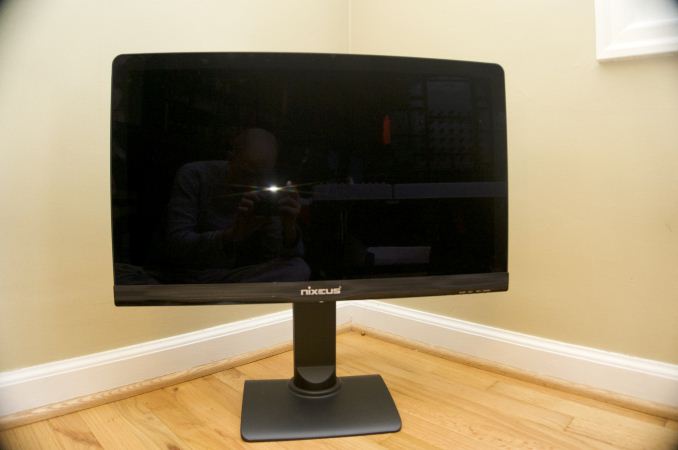
After the wave of cheap 27” monitors from South Korea hit Ebay, a number of vendors started to offer their own inexpensive models. One of the first models to hit the US, and one that I reviewed here, was the VUE27 from Nixeus. Now they have released their newest version, the VUE27D. Stripping the input selection down to a single DisplayPort input, the VUE27D reaches for an even lower price point than before. With all the changes in the display marketplace over the past year, how will the VUE27D fare today?
The display that the VUE27D resembles most is the HP zr2740w. Like that model the VUE27D offers no on-screen display at all, only controls for brightness with no indicator for level. Combined with a single DisplayPort input there really is nothing at all to adjust on the VUE27D. There is a reset button to take the brightness level back to the original setting, but that is it. There are extra buttons that do nothing as well, as it appears Nixeus uses generic off-the-shelf parts.
Compared to the other VUE monitors from Nixeus, the VUE27D is very thin. Most of the screen is very narrow except for the center where the inputs and stand are located. Part of this is managed by using an external power supply to cut down on internal bulk. I’m still not a fan of external power supplies, but it helps keep a display cooler and makes it easier to sell around the world.
The back of the VUE27D is a fine diamond texture as opposed to the flat plastic we usually see. Almost no one will see it because it's on the back of the display, but it is a nice look.
The stand offers height adjustment along with swivel, and you can rotate the display to use it in portrait mode. This is more flexibility than any of the other affordable displays to come my way and makes setup much easier. The specifications indicate there is tilt available, but the model that I have does not tilt at all. The joint might just be adjusted too tight, as I've seen this on other review samples, but in my case it doesn't work.
The anti-glare coating works fine and doesn’t cause the degradation in image quality that people often worry about. Beyond this there isn’t much to comment on for the design of the VUE27D. It drops anything non-essential and only keeps what you need.
| Nixeus VUE27D | |
| Video Inputs | DisplayPort |
| Panel Type | IPS |
| Pixel Pitch | 0.231mm |
| Colors | 16.7 Million |
| Brightness | 380 cd/m2 maximum |
| Contrast Ratio | 1000:1 |
| Response Time | 6ms GtG |
| Viewable Size | 27" |
| Resolution | 2560x1440 |
| Viewing Angle (H/V) | 178/178 |
| Backlight | White LED |
| Power Consumption (operation) | 72 Watts |
| Power Consumption (standby) | < 1 Watt |
| Screen Treatment | Anti-Glare |
| Height-Adjustable | Yes |
| Tilt | No |
| Pivot | Yes |
| Swivel | Yes |
| VESA Wall Mounting | 100mm x 100mm |
| Dimensions w/ Base (WxHxD) | 25 5/8" x 24 3/8" x 8 3/8" |
| Weight | 16.6 lbs. |
| Additional Features | NA |
| Limited Warranty | 2 Years |
| Accessories | MiniDP to DP cable, DP to DP cable |
| Price | $430 MSRP ($450 online) |
Driven to its maximum level, the VUE27D can produce over 450 cd/m2 of brightness with a white screen. Even if you are working in a very bright office or have a window behind you, this should be enough. Cranked way up you can hide most reflections that might appear. The lowest level is 111 cd/m2 which isn’t quite the 80 cd/m2 I like to see but isn’t bad.
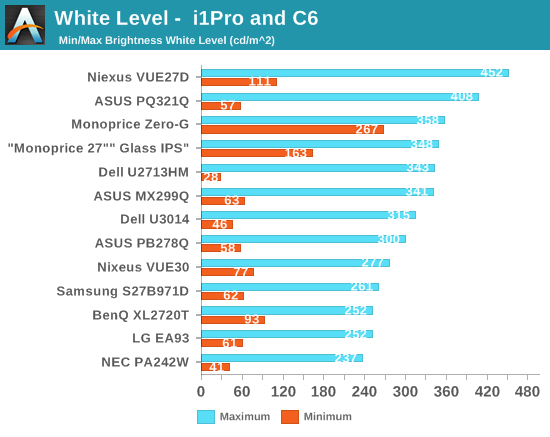
The black levels are very good for the white levels. We see 0.451 cd/m2 at maximum and only 0.111 cd/m2 at minimum. Given our white levels, these are very good results.
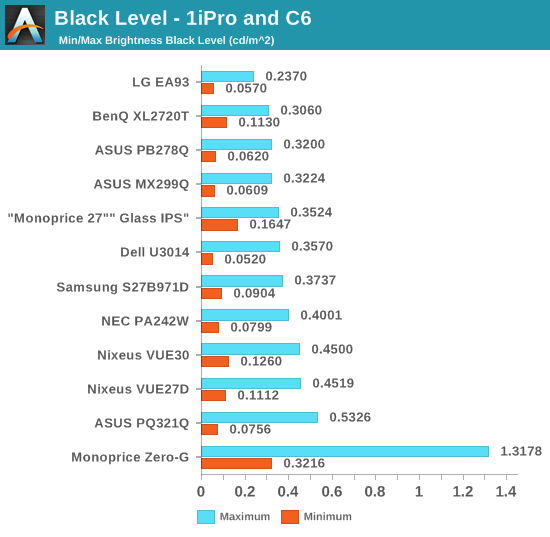
The combination of white and black levels gives us a contrast ratio of 1000:1. This is very good for an IPS panel and the level that I look for in a monitor today. The difference in contrast at maximum and minimum brightness is really nothing at all, so you can get this contrast performance at any brightness level you select.
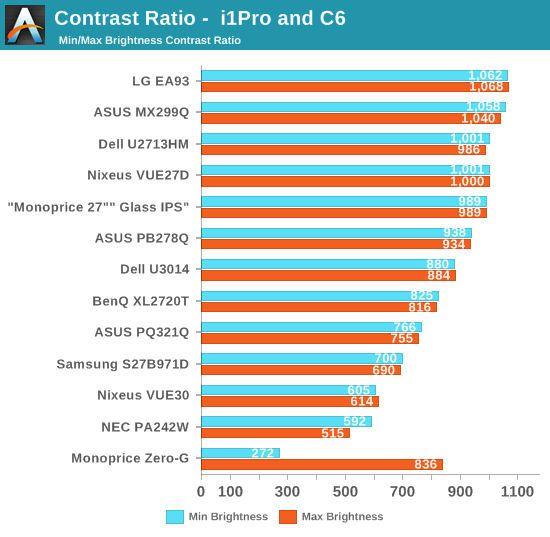
For an LED-backlit IPS panel, these numbers overall are quite good. The Nixeus is very bright, but also has a very nice contrast ratio. It will have plenty of pop for images and movies.
With no adjustment beyond brightness, and only a single input, it is easy to get results from the VUE27D that should be repeatable for everyone. For all of this testing I use CalMAN 5.1.2 with an i1Pro spectrometer and a C6 colorimeter that I profile from the i1Pro. Our targets are 200 cd/m^2 of light output, a gamma of 2.2, and the sRGB color gamut.
The initial grayscale is very lacking in blue out of the box. The color temperature of 6032 is well below the target of 6504, which provides the warm, reddish tint of the grayscale. The overall gamma of 2.19 is very close to 2.2 but it isn’t flat.
Colors also have a red/green push with the CIE chart showing a drift towards that side of the chart. The color errors are certainly visible especially with shades of cyan that have a greenish tint to them. The average errors for saturations and the color checker are relatively modest with skin tones and blue/cyan shades causing the largest errors. With no other controls available this is the performance most people should expect to see.
|
Pre-Calibration |
Post-Calibration, 200 cd/m^2 |
Post-Calibration, 80 cd/m^2 |
|
| White Level (cd/m^2) | 200.5 | 203.23 | 80.06 |
| Black Level (cd/m^2) | 0.1992 | 0.2274 | 0.1163 |
| Contrast Ratio | 1007:1 | 894:1 | 688:1 |
| Gamma (Average) | 2.1921 | 2.1958 | 2.4121 |
| Color Temperature | 6032K | 6406K | 6393K |
| Grayscale dE2000 | 5.9671 | 1.2165 | 0.7413 |
| Color Checker dE2000 | 4.2532 | 1.2528 | 1.0417 |
| Saturations dE2000 | 3.8643 | 1.2017 | 0.9421 |
Calibrating with CalMAN v5.2.0 removes these issues. We have a slight color shift in the grayscale but nothing bad at all. Our gamma becomes neutral and the contrast ratio falls a bit from 1000:1 to 900:1 but is still good for IPS. Color errors are almost completely corrected for and no samples at all pass the dE2000 level of 3.0 that people consider visible.
Calibrating for 80 cd/m2 of light and the sRGB gamma curve produces similar results. The Contrast ratio is worse as the backlight does not go low enough to hit this target easily. The grayscale and gamma are both very good and the colors are also far improved. If you have the ability to calibrate the VUE27D it has the potential to produce very accurate images.
The most recent release of CalMAN also adds the ability to test color accuracy for ICC aware applications. All the other tests involve just modifying the video card or monitor LUT, so we see how every application will work. If you are using Photoshop or other color critical work, your application is almost certainly ICC aware and can use profiles to be even more accurate.
For those applications the VUE27D can produce numbers better than anything I’ve seen to date. This is also the first monitor tested to use this ICC ability so there is nothing to compare it to. However if you are someone that can calibrate their display to get an ICC profile, and who uses ICC aware applications, the VUE27D will look virtually flawless.
If you don’t have any calibration hardware or software, the VUE27D is pretty decent out of the box. Skin tones and oceans will have a bit of a tint to them, but not a giant one. If you can calibrate it, then you’ll get fantastic results from all applications, ICC aware or not.
The thin size of the VUE27D is a bit of a turn-off when it comes to uniformity as companies typically sacrifice quality for looks. So it is a pleasant surprise to see that the VUE27D has quite good uniformity across the screen. The black level is very solid other than a single location in the lower right. That little bit of light leakage causes the black level to rise up
|
Average |
Median |
||||
|---|---|---|---|---|---|
|
White Level |
195.0 |
194.9 |
|||
|
Black Level |
0.231 |
0.226 |
|||
|
Color Error (dE2000) |
0.97 |
0.82 |
|||
|
Contrast Ratio |
863 |
892 |
The average white level across all 25-points is only 2.5% below our target, and the median value is identical. The brightness rises a bit around the center, which is unusual to see, and dims a bit around the edge like we would expect. Nothing drops below 182 cd/m2 or rises above 211 cd/m2. That isn’t ideal performance but is very good for a consumer-targeted display.
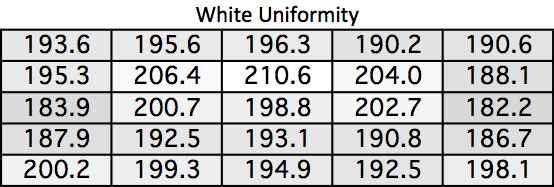

The black level is also good, though the left side of the screen is darker while the right is brighter. There is significant light leakage in the lower-right area where the black level rises by almost 50%. As the Nixeus has nice black levels for an IPS display, nearly 1,000:1, this increase isn’t as bad as it can be on other displays. The larger issue is the right side being brighter than the left side of the display.
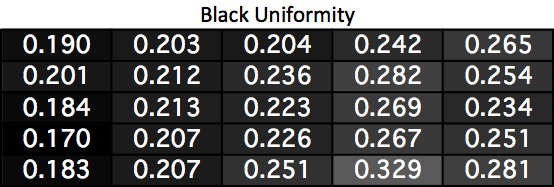

Because of this our average and median contrast ratios are good, but they are much better on the left side of the display than on the right half. We still average over 850:1 which is better than most recent IPS displays.
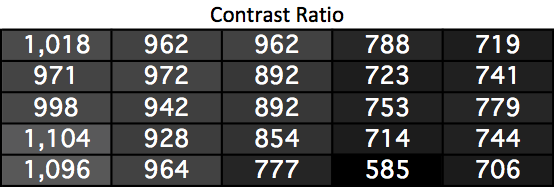

Color quality is also very good across the screen. There is a large error in the upper-left, which I measured twice to make sure the result was correct, but the rest of the screen is spot-on. If you are doing work that requires a very uniform display the VUE27D would work provided you can keep the upper left out of use.

With only a DisplayPort input, I can’t use the standard Leo Bodnar lag tester for this. I also can’t test it at native resolution against another 1440p CRT, as I don’t have one. The best I can do is take some averages for different lag tests and come up with my overall average.
Using this, admittedly imprecise, method I find the Nixeus VUE27D has an input lag of only 20ms. With no on-screen display or color adjustment that take time to process, we get a nice lag number here. This comes out ahead of almost all the other 27” monitors tested. If you want a display for gaming that is 1440p, the new recommendation is going to be the VUE27D.
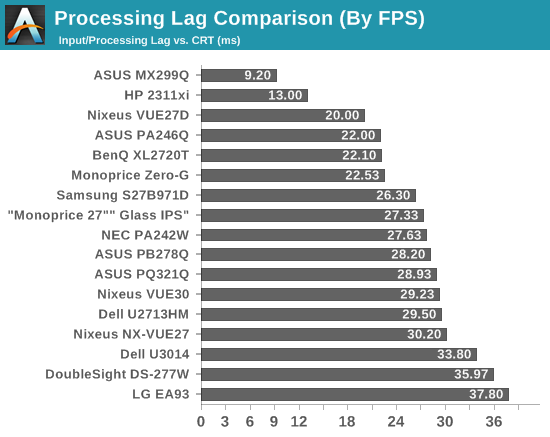
Power Use
The VUE27D does well on power measurement ratings. The maximum power use is higher than other monitors but it is very good on a watt-per-candela basis. It maintains this even at lower light levels, while some monitors don’t, so it is more efficient at more commonly used light levels.
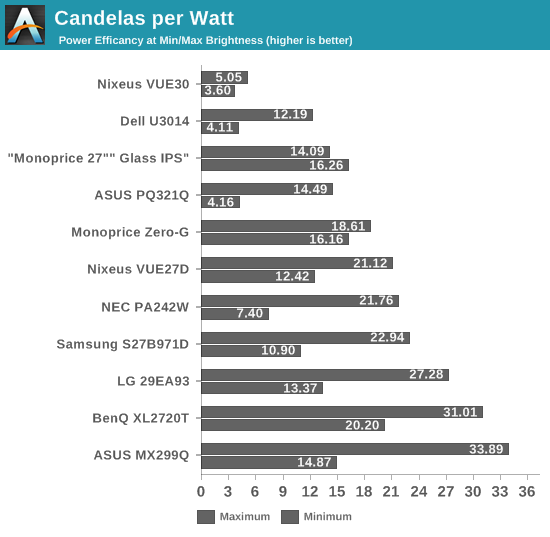
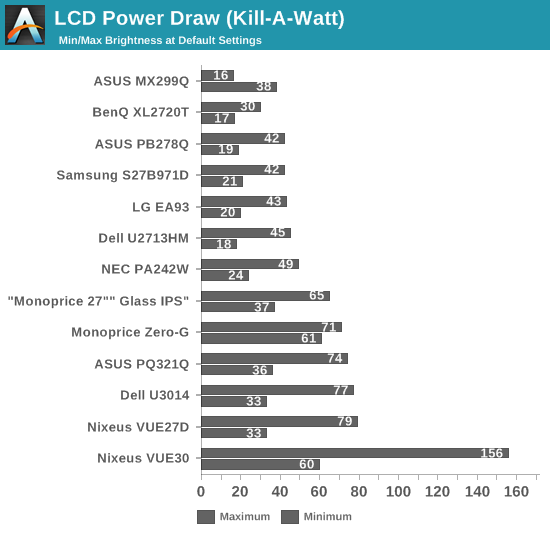
Color Gamut
The VUE27D has a larger-than-sRGB gamut with almost 75% of the AdobeRGB gamut being present. The gamut is a little bit larger in Blue/Red compared to sRGB but not so much that we see a lot of over-saturation of colors. This is pushing the limits of a white-LED backlit display as going larger means CCFL or G-B LED lighting systems.
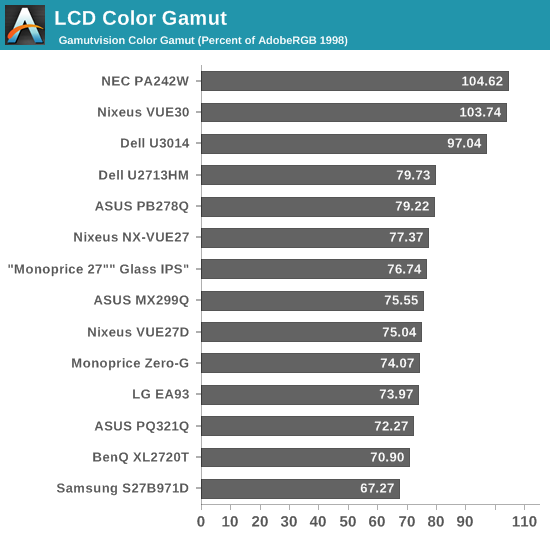
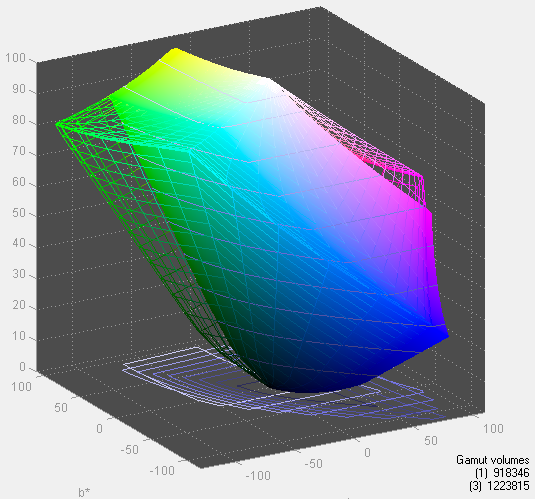
The main question for the Nixeus VUE27D is how many people are fine with just a DisplayPort input? For Mac users, the cheapest 27” displays haven’t been ideal choices as they only offer DVI inputs and you’d need an active DisplayPort to DVI adapter to use them with a MacBook. Most monitors with DisplayPort inputs have cost a good bit more, but the VUE27D has recently been selling for only $370, cheaper than other DisplayPort options.
You are very limited in adjustments with the VUE27D as only brightness controls are available. The color quality out of the box is okay, but the grayscale quality is worse with a reddish tint that I can see. Most people tend to push their displays more towards the blue end of the color spectrum than the red end, so this might turn some people off. For people without any ability to calibrate their display, there is no way to get rid of this tint.
If you can calibrate, the Nixeus produces a very nice image. The contrast ratio is very good and the one thing I would want to change is to have a lower minimum light level. Because the minimum level is too high it can’t do our sRGB/80 cd/m2 target as well as other displays. Most people will run their display higher than this, but for people after an inexpensive display for doing professional work it is a bit disappointing.
Overall, if you can find the VUE27D selling for $370 as we've seen recently, it winds up as a decent value but not a spectacular one. The more flexible stand is nice to see and helps a bit with the value. However the current price for the Nixeus is around $450, and for $438 you can get the Monoprice Glass Panel Pro. It has a worse stand but more inputs and adjustments available. With that current price difference you can even get an aftermarket stand and the Monoprice becomes a much better value. It seems to have slightly more lag, but the measurements for these two displays are different so I can’t be certain of that either.
There are no major flaws or defects with the VUE27D, and it is a nice follow-up to the prior VUE27. However, the market has changed a bit since our VUE27 review, and for the current street prices I feel the Monoprice Glass offers a bit more value. If the Nixeus goes back to its prior price, or even a bit lower, then it can stand out more against the $300 DVI-only models, but at the current price it comes in a bit too high.











































